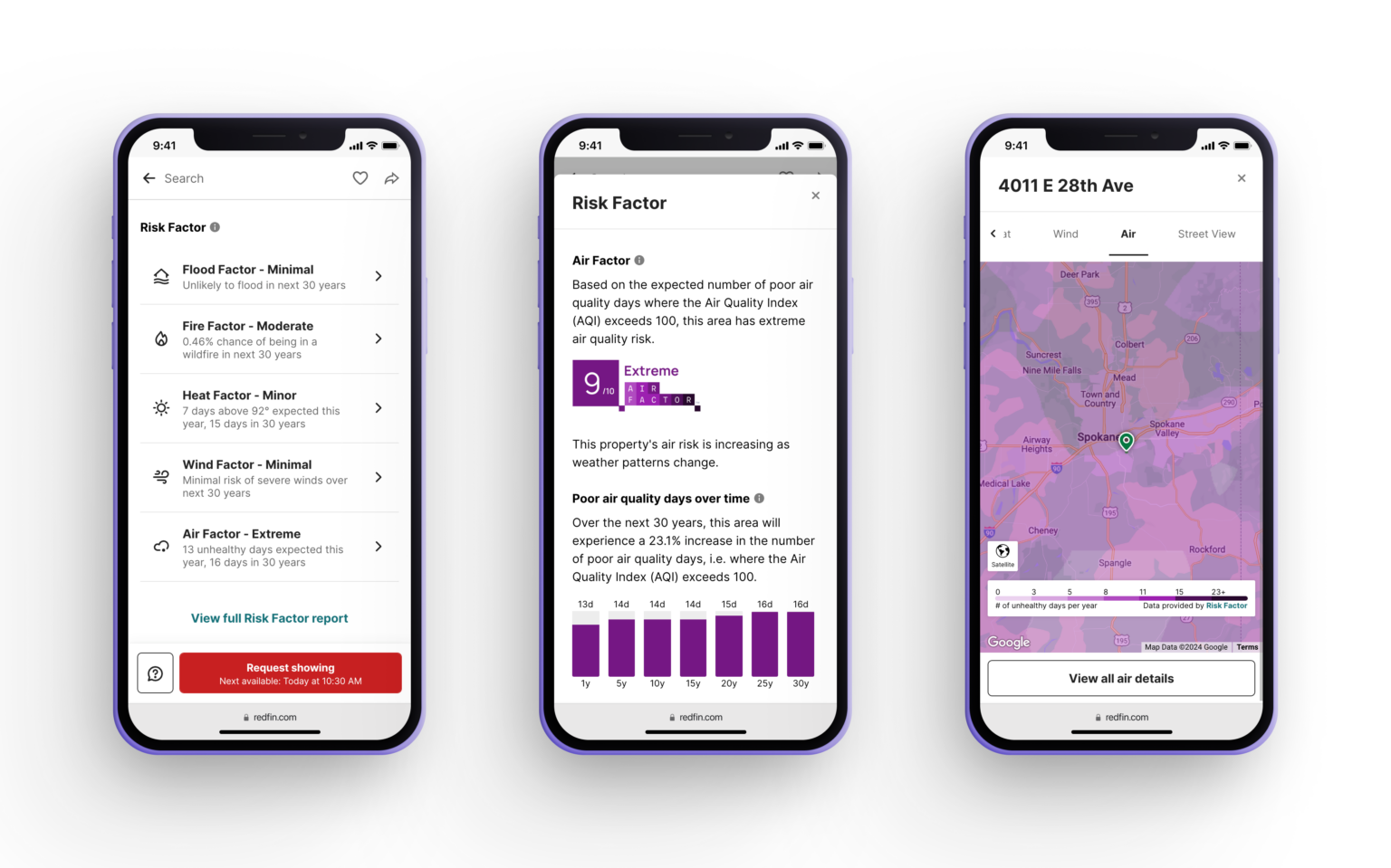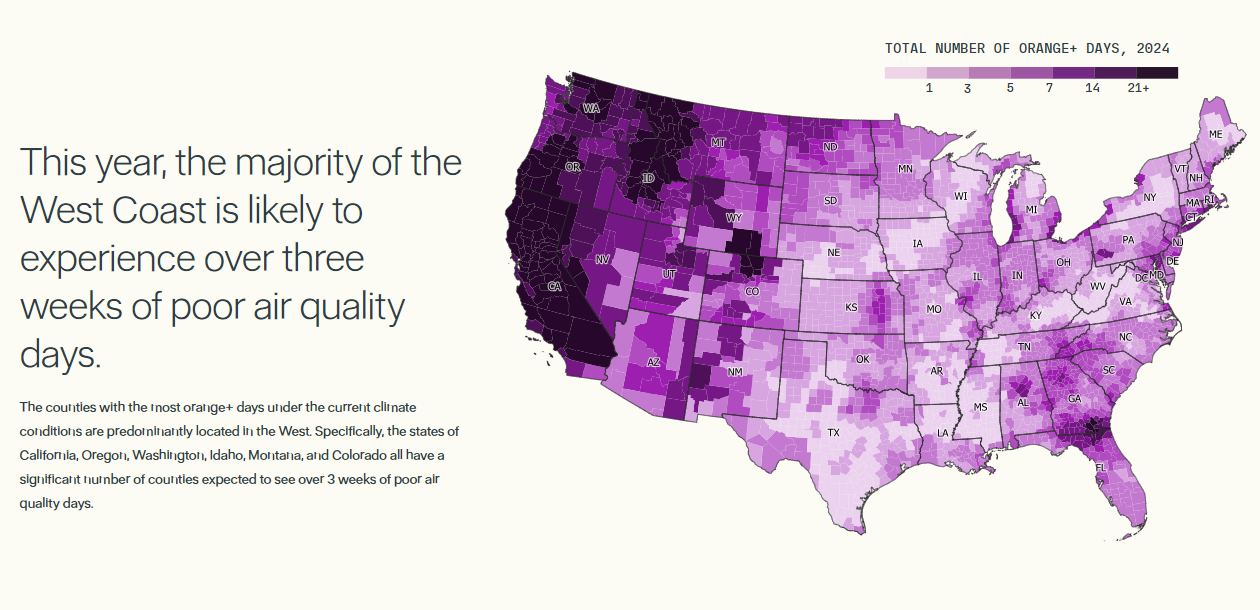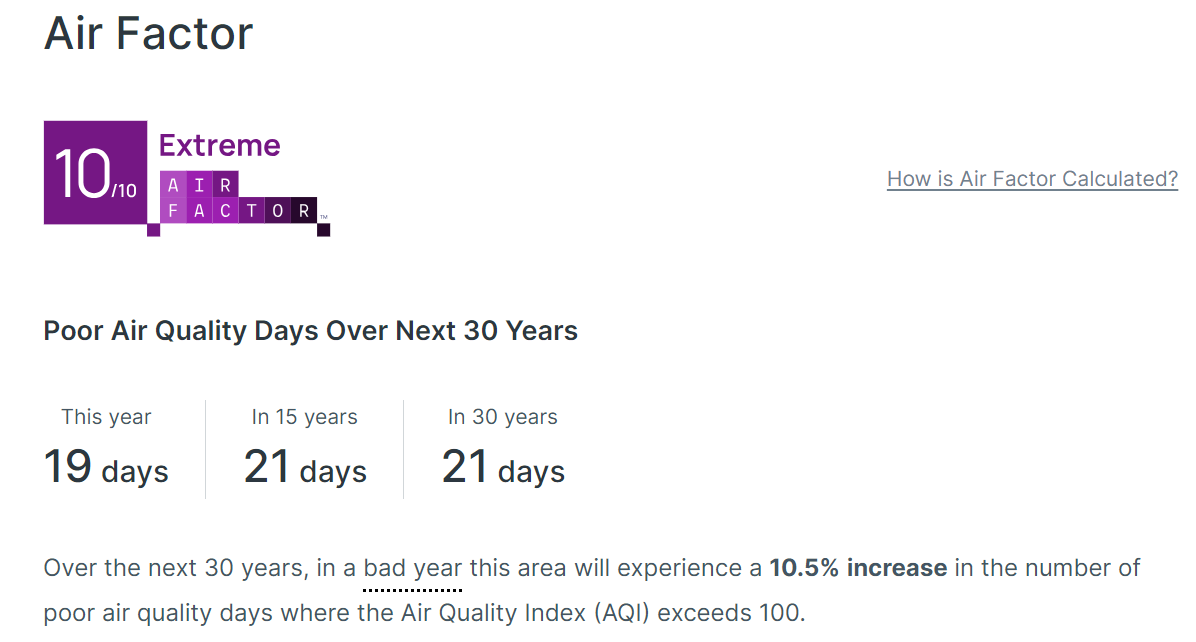Is Air Pollution Harming Your Health and Home Value?
A quarter of Americans are exposed to air pollution deemed "unhealthy." A free app from Redfin shows your property risk and what you can do about it.


Air pollution can devastate your health. It may lead to lung or heart disease, dementia or even premature death, according to the American Lung Association. Until recently, it was difficult to know what your exposure might be given where you live, or if your air quality was likely to improve or worsen in your area. A new app and website show the risk of poor air quality for any U.S. residential address now and in the future.
The Air Factor tool, developed by First Street Foundation in partnership with the tech real estate company, Redfin, quantifies that risk. The tool is based on research that examined poor air quality in the U.S. due to ozone (formed when hot temperatures combine with emissions from a car or factory) and wildfire smoke.
"This is really a Western story," said Dr. Jeremy Porter, head of climate implications for the foundation. Although ozone pollution is a serious problem in much of the U.S., wildfires in the west and along the border of Florida and Georgia contribute to the worst air pollution in the country. The map below shows the number of "orange" (unsafe for sensitive groups) or worse days projected for 2024.

Sign up for Kiplinger’s Free E-Newsletters
Profit and prosper with the best of expert advice on investing, taxes, retirement, personal finance and more - straight to your e-mail.
Profit and prosper with the best of expert advice - straight to your e-mail.

How do I see a home's air pollution risk?
The Air Factor tool assigns each U.S. property a rating from one (minimal risk) to ten (extreme risk). Minimal risk means that the property is unlikely to experience any days of unhealthy air each year, while extreme risk means that 21 or more days will be unhealthy in a given year.
There are a few ways you can access the rating for your own home, or a home you might purchase in the U.S.
If you have an Apple phone: Download the free Redfin iOS app. From the main page, type in the address to search. From the property's landing page, select the "climate" button. It may be on the upper right-hand side of your screen, or you may have to scroll through the listing. Click on "Air Factor." If you would prefer not to download an app you can use the instructions below.
If you have an Android phone or are searching from a computer or tablet: Go to Riskfactor.com. Enter an address to search. You will see five scores for the property detailing climate risk "factors," from flooding, wind, heat, fire and air quality. Click on "Air Factor."
Next steps: You will see an Air Factor score from one to ten, as explained above. You will also see the home's current and future number of unhealthy air days.
Here is an example of the Air Factor score for a property listed for sale in Portland, Oregon, for over a million dollars.

If you moved into this house, you could expect almost three weeks of unhealthy air per year. Portland used to have excellent air quality, but the quality has degraded substantially over the past few years, largely due to wildfires.
Will a high Air Risk score lower my home's value?
The short answer? It's complicated. What's clear is that there's been an exodus from some of the most polluted areas in the country to those with cleaner air. The U.S. metro areas with poor air quality had about one million people move out between 2021 and 2022, according to a recent Redfin study. Cleaner metro areas saw one million more people moving in than out during the same period.
Consider that many areas with wildfire risk are in highly-desirable locations near forests, or with plenty of greenspace. As a result, these areas tend to share both wildfire risk and higher home values. Roughly 9% of respondents said that they were moving due to climate concerns like wildfire smoke, according to a recent Redfin survey, while 20% said they were looking for cheaper housing.
Moving away from wildfire risk is no guarantee that you won't encounter another problem, such as flooding. A 2023 study by Redfin found that Americans leaving western states are flocking to areas with high wind and flooding risk. In some cases, moving to Florida, Arizona or Texas for cheaper housing could wind up costing just as much as a pricier area when factoring in expensive home and auto insurance, or even rebuilding after a storm.
What can I do if my home has a high Air Risk score?
For general advice on how to improve your home's indoor air quality you can follow advice from Risk Factor or the EPA. In addition to portable air filters, improving sealing and insulation can help keep pollution out of your home. If that sounds too costly, remember that insulation and replacement windows may qualify for energy efficiency home improvement tax credits under the Inflation Reduction Act.
If you want advice tailored to your specific home, a subscription-level service to Risk Factor might be helpful. You could sign up for a free, seven-day trial and then cancel your subscription before the monthly fee of $29.99 applies. Once you've signed up, click the "Indoor Air Quality Calculator" tab for your home in the Air Risk section of your home profile. You'll be able to modify your home's existing profile that Risk Factor automatically uploads from public documents (for example, the home's age, what construction material it's made of, and size). Then you can see how various remediations like air filters or insulation could improve your indoor air quality.
Beyond pollution risk
As you explore your home's Air Factor score, you may notice other climate-related scores. Risk factor also offers free scores on residential properties for flood, fire, wind and heat risks. Just as with Air Factor, type in your home address at Riskfactor.com to see these scores.
If you're thinking of moving but haven't yet picked out a specific property to research, you may also search the site by city or county name. This is a great way to learn about an area's risks, but also the steps that local governments are taking to lessen risks for homeowners. Denver, Colorado, for example, has a major wildfire risk, but it is one of the most prepared cities to handle climate extremes, according to Architectural Digest.
Read More
Get Kiplinger Today newsletter — free
Profit and prosper with the best of Kiplinger's advice on investing, taxes, retirement, personal finance and much more. Delivered daily. Enter your email in the box and click Sign Me Up.

Ellen writes and edits retirement stories. She joined Kiplinger in 2021 as an investment and personal finance writer, focusing on retirement, credit cards and related topics. She worked in the mutual fund industry for 15 years as a manager and sustainability analyst at Calvert Investments. She earned a master’s from U.C. Berkeley in international relations and Latin America and a B.A. from Haverford College.
-
 Vanguard Is 50! Here's How It Has Made Investing Better
Vanguard Is 50! Here's How It Has Made Investing BetterVanguard was established by John C. Bogle in May 1975, and the fund manager's impact on investing has been revolutionary.
-
 Should You Give up a Car in Retirement?
Should You Give up a Car in Retirement?If you own two cars, shedding one might be easier than you think. And the freedom from rising vehicle expenses can bring relief to retirees.